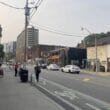The dangers of death or serious injury from traffic accidents have been exposed as a “postcode lottery” by the lack of 20mph speed limits on thousands of streets across Scotland.
A freedom of information survey has revealed that several local authorities have only a small number of streets with permanent 20mph limits, allowing faster speeds on many roads in residential areas. One council – Falkirk – has no roads at all with full-time 20mph limits.
In North Ayrshire and East Dunbartonshire there are only 10 streets with permanent 20mph limits. Perth and Kinross has just 11 streets with the limits and Inverclyde has 24.
Dundee has 44 streets with permanent 20mph limits. This compares to 650 in Aberdeen, 2,268 in Edinburgh and over 200 kilometres of roads in 74 areas of Glasgow.
Studies have shown that curbing the speed of cars, vans and lorries in residential areas reduces accidents. A report in November 2016 to Calderdale Council in West Yorkshire concluded that the introduction of a 20mph limit had led to a 22 per cent drop in road casualties.
According to the City of Edinburgh Council, pedestrians are seven times less likely to be fatally injured if hit by a car at 20mph compared to 30mph. More than half of Edinburgh’s streets now have 20mph limits, and it’s aiming to become Scotland’s first 20mph city.
The Scottish Greens environment spokesman, Mark Ruskell MSP, is planning to introduce a bill to the Scottish Parliament to cut the normal speed limit in residential areas from 30mph to 20mph. His staff asked all 32 local authorities in Scotland to say how many streets they had with 20mph limits.
“Children and the elderly are being put at unnecessary risk of injury and death by our failure to deliver consistent speed reduction where people live,” he said.
“This postcode lottery of uncompleted patchworks of part-time 20mph zones across our towns is not enough to deliver safe communities. I believe we need to change the law so that 20mph rather than 30mph is the default speed limit in residential areas.”
Ruskell argued that lowering the speed limit greatly increased the chances of surviving a car crash. “There are stories of frustration from communities across Scotland where reducing speed limits has proved a real struggle,” he said.
“The pace of change is too slow, so new legislation is needed to make it easier for councils to reduce speed limits consistently.”
After a two-year-old girl, Harlow Edwards, was killed by a car crash in Couper Angus in Perthshire last October, local people changed a 30mph road sign to read 20mph. The police reportedly threatened the culprits with prosecution for defacing the sign.
Ruskell’s proposed bill has been backed by road safety campaigns, and welcomed by some councils. The 20’s Plenty for Us group estimated that a nationwide speed limit would save £15 million by reducing the number of signs needed.
“Leading cities have already begun their 20mph programmes, even though it can be done more cost effectively as a national speed limit,” said the group’s campaign manager Anna Semlyen.
“The time is now to help all of Scotland’s urban residents to enjoy safer, cleaner, better roads.”
Lucy Amos, spokeswoman for the road safety charity, Brake, pointed out that a national limit would cut bureaucracy for councils. “Towns, villages and cities should be places where people are free to travel in ways that are safe, sustainable, healthy and fair,” she said.
“Unfortunately, there are still too many places in Scotland where this is not the case.”
Edinburgh’s transport convenor, Lesley Hinds, said the city was making a “bold move” aiming for all streets in built-up areas to have 20mph limits. “We fully support calls to make 20mph limits the default in residential areas,” she said.
The council is planning to extend the limit to another 795 streets in the next financial year. “The scheme focuses on residential and shopping streets, aiming to encourage a safer, more welcoming atmosphere for all road users,” she added.
Glasgow City Council is planning to double the length of roads subject to 20mph limits so that 35 per cent of residential roads will be covered. “We appreciate not every road in the city is suitable for a 20mph limit,” said the council executive member for transport, Elaine McDougall.
“We continue to look at innovative methods to reduce speed within our communities and would welcome any proposal which makes it easier for councils to deliver and implement.”
Falkirk Council told the Scottish Greens it had “no permanent 20mph speed limits within the council area”. But a spokeswoman stressed that the council did have 152 part-time 20mph limits outside schools that applied when children were arriving or leaving.
“We are aware that both Edinburgh and Glasgow city councils have implemented extensive 20mph schemes and we await results from these schemes in terms of speed and accident reduction,” she said.
“Until then, we have no plans to extend the implementation of 20mph speed limits to locations outwith the immediate vicinity of schools.”
North Ayrshire Council also pointed out that it had part-time 20mph zones at 63 schools. “There are currently no consultation proposals or plans to introduce 20mph speed limits as a matter of course in residential areas,” said the council’s commercial service head, Russell McCutcheon.
“We would, however, consider that option if future assessments provided evidence that casualty reduction benefits could be achieved at specific locations.”
Dundee City Council highlighted its adoption of traffic calming and pedestrianisation, as well as 20mph limits. Some communities were asking for more 20mph limits and they would be delivered, said the council’s development convener, Will Dawson.
“One injury on our streets is one too many and when evidence from around the country shows that bringing in 20mph zones can have benefits, I think it is vital that we investigate any way of helping us to reduce accidents and injuries.”
The Scottish Government, however, did not back a nationwide 20mph limit. “We believe decisions on urban speed limits are best taken at local authority level so there are no current plans to lower 30mph limit to 20mph on a national basis,” said a spokeswoman for Transport Scotland.
“The Transport Minister Humza Yousaf recently met with Mark Ruskell MSP regarding the Green Party’s plans to bring forward legislative proposals on 20 mph speed limits which we will consider once we see further detail.”
Councils’ 20mph streets and accident rates
| Local authority | Number of permanent 20mph streets | Serious injury rate from accidents (2013, per 100 million vehicle kilometres) |
|---|---|---|
| Falkirk | 0 | 3.6 |
| North Ayrshire | 10 | 5.31 |
| East Dunbartonshire | 10 | 1.9 |
| Perth and Kinross | 11 | 7.18 |
| Inverclyde | 24 | 2.29 |
| Orkney Islands | 24 | 3.01 |
| Comhairle nan Eilean Siar | 29* | 0.49 |
| Moray | 40 | 8.43 |
| Dundee City | 44 | 4.59 |
| Highland | 64 | 3.07 |
| East Lothian | 69* | 4.92 |
| Scottish Borders | 79 | 6.99 |
| Shetland Islands | 90 | 1.96 |
| Argyll and Bute | 105 | 4.95 |
| Angus | 118 | 6.21 |
| West Dunbartonshire | 120 | 3.94 |
| North Lanarkshire | 206* | 3.79 |
| South Ayrshire | 344* | 2.46 |
| South Lanarkshire | 370 | 4.47 |
| Aberdeen City | 650 | 8.65 |
| Stirling | 725* | 6.26 |
| Fife | 4,804* | 3.41 |
| Glasgow City | 206km | 7.15 |
| Edinburgh City | 2,268 | 5.86 |
| Clackmannanshire | 100% of residential streets | 4.32 |
| Aberdeenshire | n/a | 6.88 |
| Dumfries and Galloway | n/a | 6.29 |
| East Ayrshire | n/a | 3.81 |
| East Renfrewshire | n/a | 2.43 |
| Midlothian | n/a | 3.97 |
| Renfrewshire | n/a | 4.37 |
| West Lothian | n/a | 4.43 |
Sources: Scottish Greens, local authorities and Transport Scotland
Cover image thanks to Colin Smith under this Creative Commons Licence, and photo thanks to Edinburgh Greens, CC by 2.0.
A version of this article was published in the Sunday Herald on 12 February 2017.














